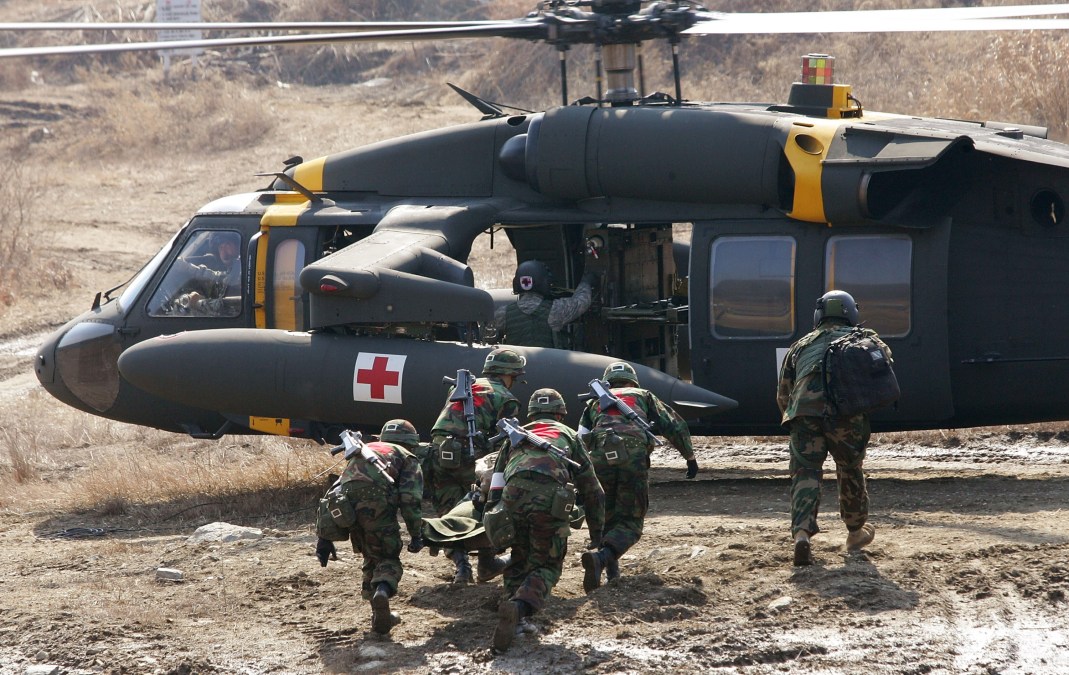DARPA launching research project to revolutionize brain injury diagnosis on the battlefield

Serving as a leader in military medicine since the 1990s – including as director of force health protection for U.S. and NATO units in southwestern Afghanistan — Cmdr. Jean-Paul Chretien is familiar with the complex damage that traumatic brain injury (TBI) can cause.
In an interview with FedScoop, the naval medical officer, who now leads a soon-to-launch research project at the Defense Advanced Research Projects Agency (DARPA), explains the threat that this type of injury poses to U.S. military readiness.
“I’ve come to appreciate the challenges that we face with traumatic brain injury (TBI) for service members in training environments and operational settings,” he told this publication.
Chretien is spearheading the department’s New Technology for Non-Invasive Intracranial Pressure Monitoring research project, which is intended to produce a non-invasive device that can capture data and enable health personnel to assess TBI severity accurately in a theater of war, where resources are scarce.
The impact of this condition is broad, with roughly 450,000 military service members were diagnosed with TBI between 2000 and 2020, including more than 16,000 in 2020, according to the Military Health System. A recent study in the Journal of Head Trauma Rehabilitation also demonstrated that military members with TBI are at markedly increased risk of disability — and those who sustained a concussion while in combat, had lower education and were younger when injured, among other factors — had “very high odds of poor long-term outcome trajectory” from such wounds.
Non-invasive devices DARPA aims to innovate via this fresh program could help improve the outcomes of injured military personnel in future combat environments.
Diagnosis in the field
“One of the most difficult challenges around traumatic brain injury is the early identification of the injury and optimizing treatment, or getting the treatment just right for the patient at a given time,” according to Chretien.
That’s partly because skulls are hard and rigid structures of bone.
“So if someone has a brain injury — they’re exposed to an explosion, or something penetrating the skull — that can cause bleeding within the skull and cause swelling,” Chretien noted. “And those things, they take up space, but there’s no room for the skull to expand.”
Traumatic brain injuries can easily become life threatening. In moderate and severe cases, intracranial pressure elevation from brain swelling or bleeding can cause brain damage or death.
According to Chretien, faster diagnosis in the field lies at the center of improving the survival chances of patients with such injuries.
“We have a whole range of medical and surgical treatments for bringing the pressure down — but measuring the pressure and monitoring it over time and treatment now requires drilling a hole and inserting a probe,” said Chretien. He added: “So, if we had a way to monitor the pressure inside the skull with no risk, ease-of-use technology, that would really be a gamechanger for care of patients with [TBI]. That would be useful in civilian settings too, but especially in military field settings.”
The DARPA project he leads is focused on finding new technology that could allow medics to immediately identify intracranial pressure, without conducting the invasive diagnostic tests that require a hospital and technical surgical procedures.
As a program manager, he intends to help innovate the development of such a device. It will mark the next project in his expanding portfolio that’s largely focused on military medicine, combat casualty care, and other problems that he’s “most familiar with, and most passionate about trying to solve.”
The Defense Department invests more than $1 billion annually in small business-made technologies through its Small Business Innovation Research (SBIR) program. Once this new DARPA-led SBIR project opens July 29, small businesses will submit proposals and compete to help develop a device that accurately measures ICP non-invasively, is simple to operate and is suitable for both in-hospital and pre-hospital settings, according to pre-release documents.
“This is definitely a capability that has been of interest for many years,” Chretien said. “And this is not to take away from any of the technologies that do exist now or that have been reported in the scientific literature — but there’s nothing available now that meets all the criteria that we would need for use in a field setting.”
In particular, the technology “can’t require the amount of technical skill that you only find in a hospital-based subspecialty,” and must be easy to use in austere or challenging settings, the physician noted. Further, it must provide continuous measurements, not just a spot check on whether a patient’s pressure is high or low, but the ability to show changes over time.
DARPA, by the nature of the agency, takes an experimental approach to solving problems, and in this case Chretien is hoping to be surprised with proposals for ideas that others haven’t thought of before.
“We don’t want to stifle that creativity. We want to encourage it,” Chretien said. “So I can’t predict what will come in.”
An open-ended approach to possibly lifesaving tech
Though he couldn’t be prescriptive about what the resulting technology may look like, Chretien said he “definitely” sees artificial intelligence and machine learning playing a “big part” in the development and application of the envisioned monitors.
“One of the ideas that is getting a lot of interest in the critical care community now is the concept of ‘what is the optimal intracranial pressure for a given patient?’” he explained.
Most existing guidelines provide a particular value for clinicians to try to achieve. But an idea that is growing in interest in the field is that perhaps that value may be different for each patient, depending on their physiology or injury patterns. In Chretien’s view, AI and machine learning could play a key role in exploring whether that is the case and if there should be individual specific treatment targets.
“This technology is not going to tell us what the target is, but it could enable the research that would get us there,” he said.
Regardless of the approach proposers take, down the line, software and sophisticated analytics may also one day be used to filter out the inevitable noise associated with the devices to establish a clean and clear signal.
And another possible use for AI and machine learning in this pursuit has to do with monitoring patients with critical illness, Chretien noted.
“If we have this ability to measure intracranial pressure non-invasively, and we have other continuous measurements to which is common in an intensive care unit, and it’s increasingly possible in les- resourced settings, how do we take all of that information and use it to gain a better understanding of the patient’s current status, and what treatments they need at a given time — and what treatments they may need in the future?” he explained.
The potential devices could also enable “that data to get a much broader patient population than it is now,” according to Chretien. “So, AI definitely has a role there.”
DARPA projects can take as long as four years to unfold, but Chretien added that the agency is focused on swift development of a device in as quick as two years. The project also requires approved clinical study on living humans, and could culminate in the submission for Food and Drug Administration (FDA) clearance of the produced device.
“We want to see how well this device performs in actual patients who have brain injury. So, this is not just a development of a device in a lab and some kind of laboratory model, or even an animal model. This is for human patients, and so I think that’s going to give us early indication of whether we have a successful approach here,” Chretien said.




